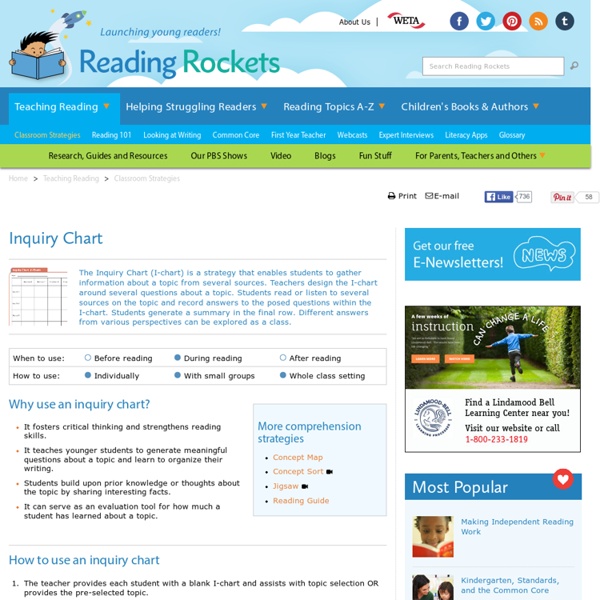



Inquiry Charts (I-Charts) Classroom Strategies Background The Inquiry Chart (I-Chart) is a strategy that enables students to generate meaningful questions about a topic and organize their writing. Students integrate prior knowledge or thoughts about the topic with additional information found in several sources. The I-Chart procedure is organized into three phases: (1) Planning, (2) Interacting, and (3) Integrating/Evaluating. Benefits This instructional strategy fosters critical thinking and strengthens reading skills. Create and use the strategy The teacher directs students as they begin with the planning phase of this activity. identifying the topic, forming questions, constructing the I-Chart, and collecting materials The next step is to engage students in the interacting phase which involves: exploring prior knowledge,sharing of interesting facts, and reading and rereading Finally, teachers guide the students through the integrating and evaluation phase by: summarizing comparing researching, and reporting
Fredrik Sandström | Om svenska och digitala verktyg austcurr_gi_web20_unit-template-master.pdf Lesson Plan - Netiquette Objective: Understanding proper behavior when communicating online Instructions: Have students read the following articles: Netiquette [ E-mail Etiquette [ Smileys [ Discussion: 1.Why are rules of conduct important when communicating online? 2.What rules should keep in mind when online? 3.What are some good things to do in your online communication? 4.What are some things to avoid? 5.What are some useful abbreviations to use in your messages? 6.How can you convey emotions in an electronic message? 7.What are FAQs and why are they important? Activities: 1.Divide the class into pairs. 2.Have students use a search engine to find some online FAQs. 3.Have students test their knowledge with our interactive Netiquette Quiz.
Inquiry-Based Lesson Plans Inquiry Learning Student understanding is the central focus of inquiry learning. Students actively participate in inquiry learning experiences by developing questions and investigating to find solutions. Teachers facilitate learning as students engage in active problem solving, the construction of meaning and the communication of new understandings to students, teachers or other important adults. Teachers guide student learning by selecting, designing and planning learning tasks, asking probing questions, observing students at work to identify misconceptions and planning follow up experiences. Though inquiry learning is a component of all areas of the curriculum, mathematics and science is the focus of the elementary inquiry lessons. Search for a Lesson Plan Return to Teach 21 Home
The Nominees - 134 YouTube channels that will make you smarter The 60 YouTube channels that will make you smarter were selected from this master list. In here you can find many captivating channels that for some reason or other didn’t quite reach the shortlist. That shouldn’t take away from their standalone awesomeness though! In addition, you’ll find some totally new categories of channels for your enjoyment. Spark your curiosity Vsauce — Amazing answers to questions about our world In a Nutshell — Animations that makes learning beautiful C. Crash Course — Bite-sized science and learning in many subjects Scishow — Indispensable science news, history and concepts HowStuffWorks — Your daily curiosity dose that explains the world Brit Lab — Smart-ass ammunition that’s guaranteed to impress Mental Floss — Where knowledge junkies go to get their weekly fix of trivia THNKR — People, stories, ideas that will change your perspective The Good Stuff — Great all around inspiration from PBS Hello Internet — A podcast. Experiment with the sciences Connect with technology
Just Science Now Guided Inquiry The following standards-based lesson plans—from the Beacon Learning Center—provide practical classroom applications of guided inquiry. Elementary School Lessons Roll On Structured Inquiry lesson on Force and Motion. Middle School Lessons Animals in Research—Right or Wrong?